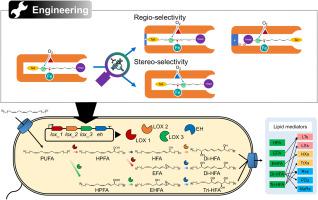Progress in Lipid Research ( IF 14.0 ) Pub Date : 2021-06-16 , DOI: 10.1016/j.plipres.2021.101110 Jung-Ung An 1 , Seong-Eun Kim 2 , Deok-Kun Oh 2

|
Oxylipins derived mainly from C20- and C22-polyunsaturated fatty acids (PUFAs), termed lipid mediators (LMs), are essential signalling messengers involved in human physiological responses associated with homeostasis and healing process for infection and inflammation. Some LMs involved in the resolution of inflammation and infection are termed specialized pro-resolving mediators (SPMs), which are generated by human M2 macrophages or polymorphonuclear leukocytes and have the potential to protect and treat hosts from bacterial and viral infections by phagocytosis activation. Lipoxygenases (LOXs) biosynthesize regio- and stereoselective LMs. Thus, understanding the regio- and stereoselectivities of LOXs for PUFAs at a molecular level is important for the biocatalytic synthesis of diverse LMs. Here, we elucidate the catalytic mechanisms and discuss regio- and stereoselectivities and their changes of LOXs determined by insertion direction and position of the substrate and oxygen at a molecular level for the biosynthesis of diverse human LMs. Recently, the biocatalytic synthesis of PUFAs to human LMs or analogues has been conducted using microbial LOXs. Such microbial LOXs involved in the biosynthesis of LMs are expected to exert significantly higher activity and stability than human LOXs. Diverse regio- and stereoselective LOXs can be obtained from microorganisms, which represent a wealth of genomic sources. We reconstruct the biosynthetic pathways of LOX-catalyzed LMs in humans and other organisms. Furthermore, we suggest the effective methods of biocatalytic synthesis of diverse human LMs from PUFAs or glucose by using microbial LOXs, increasing the stability and activity of LOXs, combining the reactions of LOXs, and constructing metabolic pathways.
中文翻译:

对用于生物催化合成多种脂质介质的脂氧合酶的分子见解
主要来源于 C20 和 C22 多不饱和脂肪酸 (PUFA) 的氧脂,称为脂质介质 (LMs),是与感染和炎症的体内平衡和愈合过程相关的人体生理反应的重要信号信使。一些参与炎症和感染消退的 LM 被称为专门的促消解介质 (SPM),它们由人类 M2 巨噬细胞或多形核白细胞产生,具有通过吞噬作用保护和治疗宿主免受细菌和病毒感染的潜力。脂氧合酶 (LOX) 生物合成区域选择性和立体选择性 LM。因此,在分子水平上了解 LOXs 对 PUFAs 的区域选择性和立体选择性对于不同 LMs 的生物催化合成很重要。这里,我们阐明了催化机制,并讨论了 LOX 的区域选择性和立体选择性及其变化,这些变化是由底物的插入方向和位置以及分子水平上的氧决定的,用于各种人类 LM 的生物合成。最近,已使用微生物 LOX 将 PUFA 生物催化合成为人类 LM 或类似物。预计这种参与 LMs 生物合成的微生物 LOXs 将发挥比人类 LOXs 显着更高的活性和稳定性。可以从代表大量基因组来源的微生物中获得多种区域选择性和立体选择性 LOX。我们重建了 LOX 催化的 LM 在人类和其他生物体中的生物合成途径。此外,我们提出了通过使用微生物 LOX 从 PUFA 或葡萄糖生物催化合成多种人类 LM 的有效方法,











































 京公网安备 11010802027423号
京公网安备 11010802027423号